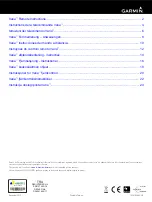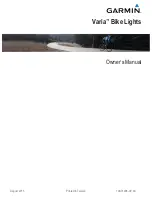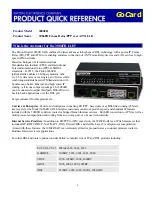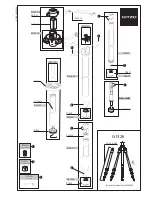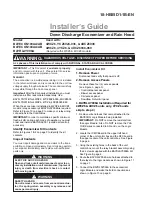
R
elea
se date
: 20
21-
03-
05
Dat
e of issue
: 20
21-
03
-0
5
File
na
me
: 277
77
1_
en
g.p
df
UC4000-L2-E4-V15
6
Germany: +49 621 776 1111
Fuchs Group
Refer to "General Notes Relating to Fuchs Product Information".
USA: +1 330 486 0001
Singapore: +65 6779 9091
www.pepperl-fuchs.com
Ultrasonic sensor
single flash: Normally Open (NO)
double flash: Normally Closed (NC).
2. Press the Programming Button briefly to toggle sequentially through these output behaviors and select the desired mode.
3. Press the Programming Button for 2 s to save and enter the programming routine for beam width.
Programming the beam width
1. The red LED flashes. The number of flashes indicates the current beam width setting:
single flash: narrow
double flash: medium
triple flash: wide.
2. Press the Programming Button briefly to toggle sequentially through these beam shapes.
3. Press the Programming Button for 2 s to save and exit the operating modes programming routine.
Reset Sensor to Factory Settings
The sensor has a feature to reset to factory settings
1. Disconnect the sensor from power supply
2. Press and hold the Programming Button
3. Connect Sensor to power supply (yellow and red LED flash simultaneously for 5 s then yellow and green LED flash simultaneously)
4. Release Programming Button
The sensor now operates with default factory settings.
Factory settings
See technical data.
The sensor is provided with three LEDs to indicate various conditions.
#
Synchronization
This sensor features a synchronization input for suppressing ultrasonic mutual interference ("cross talk"). If this input is not connected, the sensor
will operate freewheeling using internally generated clock pulses. It can be synchronized by applying an external square wave or by means of
appropriate programming via the serial interface. Each falling edge of the synchronization pulse triggers transmission of a single ultrasonic pulse.
If the synchronization signal remains low for
1 second, the sensor will revert to normal operating mode. Normal operating mode can also be
activated by opening the signal connection to the synchronization input.(See note below)
If the synchronization input goes to a high level for > 1 second, the sensor will switch to standby mode, indicated by the green LED. In this mode,
the output(s) will remain in the last valid output state. When using the external synchronization feature, please refer to the software description.
Note:
If the option for synchronization is not used, the synchronization input has to be connected to ground (0V) or the sensor has to be operated via a
V1 cordset (4-pin).
The synchronization function cannot be activated during programming mode and vice versa.
The following synchronization modes are possible:
1. Several sensors (max. number see technical data) can be synchronized together by interconnecting their respective synchronization inputs.
In this case, each sensor alternately transmits ultrasonic pulses in a self multiplexing mode. No two sensors will transmit pulses at the same
time. (See note below)
2. Several sensors (max. number see technical data) can be synchronized together by interconnecting their respective synchronization inputs.
Due to programming via the sensors interface one sensor acts as a master device, all the others as slave devices. (see description of the
interface) In this master / slave mode the sensors are triggered in parallel and are synchronized by a common synchronization pulse, provided
by the master device.
3. Multiple sensors can be controlled by the same external synchronization signal. In this mode the sensors are triggered in parallel and are
synchronized by a common external synchronization pulse. All sensors must be parameterized for external synchronization by means of the
sensor interface. See software description.
4. A separate synchronization pulse can be sent to each individual sensor. In this mode the sensors operate in external multiplex mode. (See
Factory Setting
Indication
Green LED
Yellow LED
Red LED
During Normal operation
Proper operation
Interference (e.g. compressed air)
On
Off
Switching state
remains in previous
state
Off
On
During Switch Point Programming
Object detected
No object detected
Confirmation after Programming
Programming failed warning
Off
Off
Triple flashing
Off
Flashing
Off
Off
Off
Off
Flashing
Off
Triple flashing
During Sensor Mode Programming
Programming the output function
Programming the output behaviour
Programming the beam width
Flashing
Off
Off
Off
Flashing
Off
Off
Off
Flashing
Commissioning









